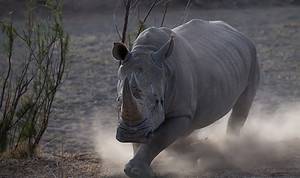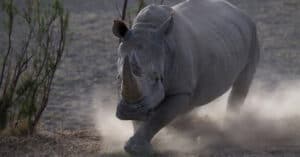Few animals on Earth command more respect than the rhinoceros. With its horned head, bulky body, and thundering gait, it is truly the master of its world. Its ancient appearance even leads some to wonder if it’s related to dinosaurs! But with rhino populations dwindling at an alarming rate around the world, their reproductive abilities have taken center stage. How many calves can a rhino birth? How long are rhinos pregnant? And how often can they reproduce? Find out all about this majestic animal below!
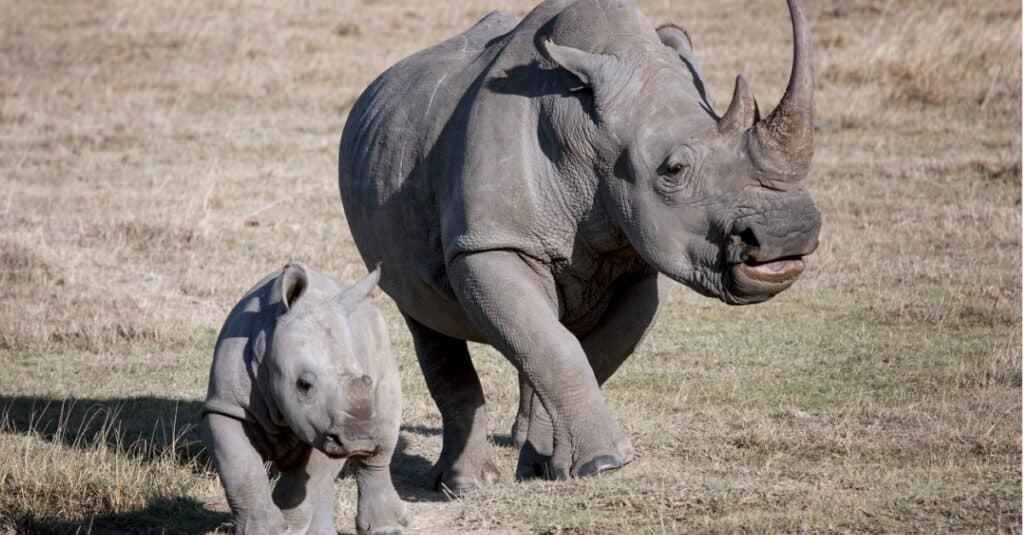
Rhinos are pregnant for 15-16 months on average.
©iStock.com/robru
Types of Rhinos
Rhinos are large, horned mammals belonging to the family Rhinocerotidae. Next to the elephant, they are the second biggest land mammal. There are 5 species of rhinos living today, all in Africa and Asia. Conservationists classify 4 of these species as Critically Endangered.
Black Rhino (Diceros bicornis)
The black rhino is the most common and recognizable of the 5 species. Though they remain critically endangered, careful conservation has given them another bid at survival. Conservationists are slowly reintroducing populations of black rhinos to areas they once inhabited, like Rwanda. Only 3 subspecies remain, as scientists have declared the Western black rhino subspecies extinct.
Black rhinos have dark hides, triangular lips, and small humps on their shoulders. They are the first of the 2-horned species. The other two are white rhinos and Sumatran rhinos.
White Rhino (Ceratotherium simum)
The white rhino is the largest of the 5 rhinoceros species. Despite its name, its hide is more gray than white. Its head is so massive that it requires a bulky hump on its shoulders to hold it up. Its lip is broad and square, enabling it to easily graze grass.
White rhinos are divided into 2 subspecies, the northern and southern white rhinos. The northern white rhino is functionally extinct.
Sumatran Rhino (Dicerorhinus sumatrensis)
The Sumatran rhino is the smallest of the 5 species. It’s also the only one with fur! Scientists believe the Sumatran rhino is the closest living relative of the long-extinct Woolly rhino. Its double horns make it unique among Asian rhinos. There may be as few as 30 individuals left in the wild.
Javan Rhino (Rhinoceros sondaicus)
The Javan rhino is the first rhino species with a single horn. Some females don’t have a horn at all. This species numbers as few as 72 individuals in the wild. Among Asian rhinos, it is smaller than the Indian rhino but larger than the Sumatran rhino.
Indian Rhino (Rhinoceros unicornis)
Though once on the verge of extinction, the Indian rhino’s numbers have climbed to the point that conservationists no longer consider this an endangered species. Instead, they list it as Vulnerable.
The Indian rhino is the second species with a single horn. It’s also the second largest species next to the white rhino. Thick, pliable skin folds give its hide the appearance of plate armour.
Rhino Appearance and Size
Rhinos exist in a range of grays and browns. The Sumatran rhino’s hair gives it a reddish tint. All are massive, bulky animals with 1-2 horns depending on their species. They have unique 3-toed hooved feet that help support and distribute their body weight.
The largest rhino species is the white rhino. It can weigh almost 8,000 pounds! On average, their weight is about 4 times that of a Sumatran rhino. They stand over 6 feet tall with a body length of just over 13 feet.
The smallest rhino species is the Sumatran rhino. They stand about 5 feet at the shoulder with a body length of 8 feet. They weigh between 1,100 and 1,760 pounds.
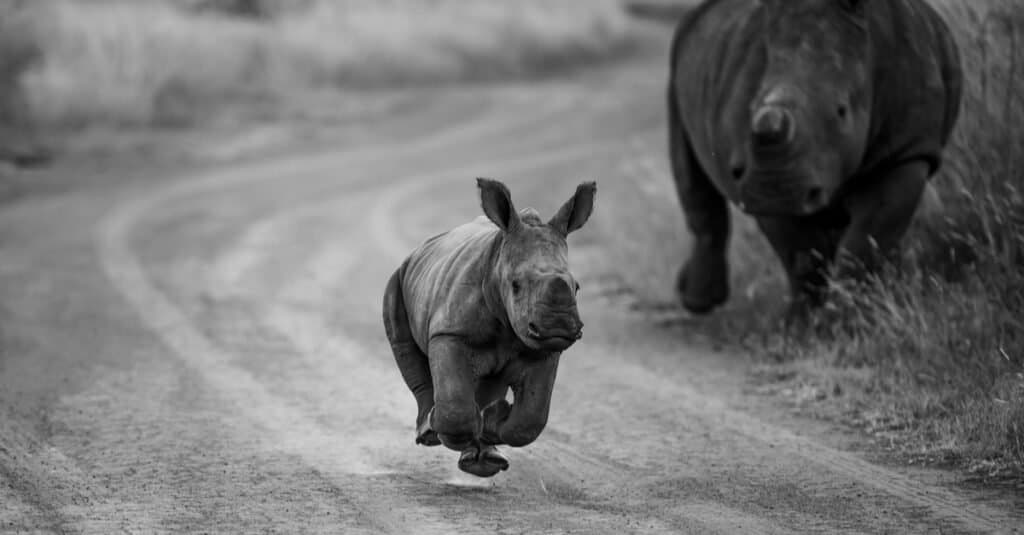
Female rhinos reproduce every 2-5 years. Calves remain with their mothers for the first 3 years of their life.
©Corrie Barnard/Shutterstock.com
Rhino Diet and Predators
Rhinos are herbivores. They subsist on plant matter like grasses, leaves, buds, roots, bark, and fruits. Some species need to consume up to 120 pounds of grass a day to survive. To consume this much, they spend many hours grazing and chewing.
With their intimidating size and aggressive temperament, adult rhinos have no natural predators other than humans. Unfortunately, humans have done a staggering amount of damage over time. Baby rhinos (calves) may also be in danger from large natural predators. Crocodiles, wild dogs, hyenas, and big cats like lions will all attack a vulnerable rhino calf.
Rhino Habitat
Rhinos live exclusively in Asia and Africa. The two African species are the white rhino and the black rhino. The Sumatran, Javan, and Indian rhinos all reside in Southeast Asia. Possible habitats include grasslands, savannas, shrublands, tropical forests, and deserts.
Rhino Social Behaviour
White rhinos are the most social of the 5 species. Mothers with calves will often group together for increased protection and socialization. The other species tend to be more solitary. Some black rhino individuals are the sole occupants of territories covering up to 100 square kilometres.
Rhinos are naturally aggressive defenders of their territories. They will charge any animal, including another rhino, that they perceive to be intruding. Because their eyesight is poor, they may confuse nonaggressive animals or inanimate objects for genuine threats. They have been known to charge nearby people and vehicles. Despite their size, they can run astonishingly fast. Black rhinos, the fastest of the five, have been known to reach speeds of 34 miles per hour!
Rhino Reproduction and Lifespan
Female rhinos are usually ready to mate by 5 years of age, though they may be sexually mature by the age of 3.5 years. To signal their readiness to mate, they whistle, urinate, and defecate. Males leave the females soon after mating.
Rhinos live between 35 and 50 years. White rhinos average a slightly longer lifespan than black rhinos.
How Long Are Rhinos Pregnant?
Rhinos are pregnant for 15-16 months, though white rhinos may carry for as long as 18 months. Among land mammals, this incredibly long gestation period is second only to that of elephants. These behemoths carry their young for as long as 23 months! Due to their extended pregnancies, rhino populations struggle to recover from poaching and disease.
How Can You Tell If a Rhino is Pregnant?
Like most other animals, rhinos grow larger and heavier as their pregnancies progress. Their abdomens swell visibly. Other than that, the best ways to determine pregnancy are by analyzing their stools or doing an ultrasound.
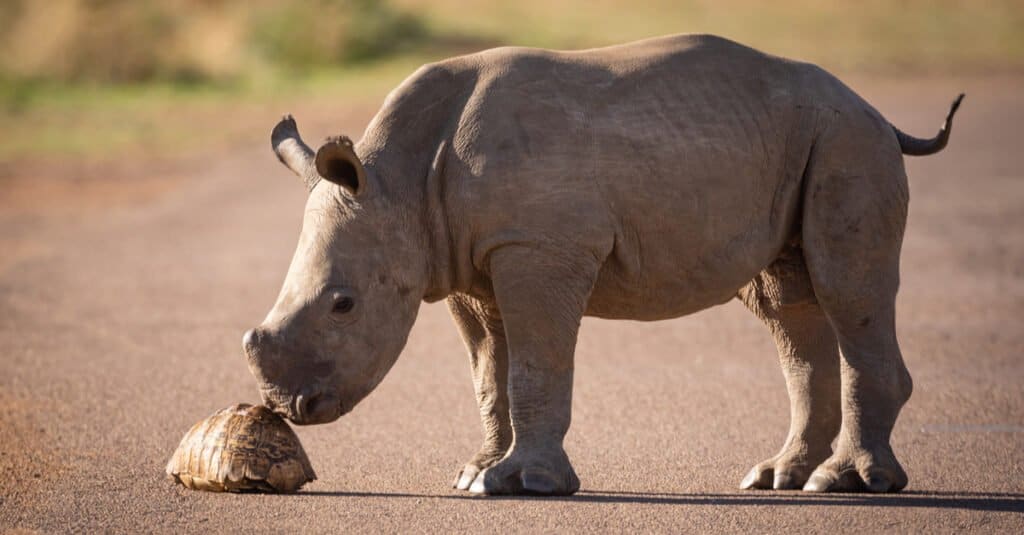
Rhinos usually give birth to a single calf. On rare occasions, they may give birth to twins.
©Heinrich Neumeyer/Shutterstock.com
How Often Can a Rhino Get Pregnant?
Female rhinos reproduce every 2-5 years. Combined with a lengthy gestation period, this means populations grow slowly, if at all. Females ovulate every 28 days and will only mate 1-2 days out of every cycle.
How Many Calves Can a Rhino Have at One Time?
Rhinos usually only have one calf at a time. Some rhinos produce twins, though this is rare. Rhino calves can weigh well over 100 pounds at birth. Though they cannot walk for the first 2-3 days, their skin is thick and durable. Mothers wean their calves at around 18 months. However, they remain with their mothers until about 3 years of age.
Rhinos may grow up to be tanks, but they make excellent mothers and even cuter calves! With care, this animal will continue to reproduce for a long time to come.
The photo featured at the top of this post is © Palenque/Shutterstock.com
Thank you for reading! Have some feedback for us? Contact the AZ Animals editorial team.



